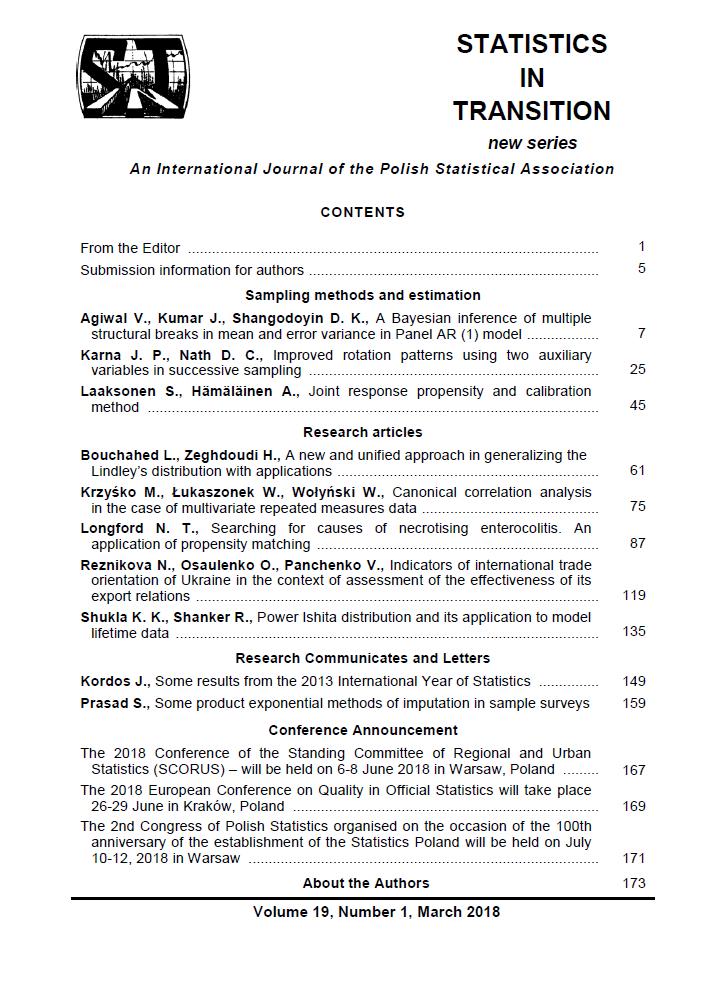ARTICLE
ABSTRACT
In this paper, we present, in the real example, canonical variables applicable in the case of multivariate repeated measures data under the following assumptions: (1) multivariate normality for the vector of observations and (2) Kronecker product structure of the positive definite covariance matrix. These variables are especially useful when the number of observations is not large enough to estimate the covariance matrix, and thus the traditional canonical variables fail. Computational schemes for maximum likelihood estimates of required parameters are also given
KEYWORDS
canonical correlation analysis, repeated measures data (doubly multivariate data), Kronecker product covariance structure, maximum likelihood estimates.
REFERENCES
DERĘGOWSKI, K., KRZYŚKO, M., (2009). Principal component analysis in the ´case of multivariate repeated measures data, Biometrical Letters, 46 (2), pp.163–172.
GALECKI, A. T., (1994). General class of covariance structures for two or more repeated factors in longitudinal data analysis, Communications in Statistics –Theory and Methods, 23, pp. 3105-3119.
GIRI, N. C., (1996). Multivariate Statistical Analysis, Marcel Dekker, New York.
HOTELLING, H., (1936). Relations between two sets of variates, Biometrika, 28, pp. 321–377.
KRZYŚKO, M., SKORZYBUT, M., (2009). Discriminant analysis of multivariate ´repeated measures data with a Kronecker product structured covariance ma trices, Statistical papers, 50, 817-835.
KRZYŚKO, M., MĄDRY, W., PLUTA, S., SKORZYBUT, M., WOŁYŃSKI, W., (2010). ´Analysis of multivariate repeated measures data, Colloquium Biometricum,40, pp. 117–133.
KRZYŚKO, M., SKORZYBUT, M., WOŁYŃSKI, W., (2011). Classifiers for doubly ´multivariate data, Discussiones Mathematicae. Probability and Statistics, 31,pp. 5–27.
KRZYŚKO, M., ŚMIAŁOWSKI, T., WOŁYŃSKI, W., (2014). Analysis of multivariate ´repeated measures data using a MANOVA model and principal components,Biometrical Letters, 51 (2), pp. 103–124.
LANCASTER, P., TISMENETSKY, M., (1985). The Theory of Matrices, Second Edition: With Applications. Academic Press, Orlando.
MCCOLLUM, R., (2010). Canonical correlation analysis for longitudinal data. Ph.D.thesis, Old Dominion University.
NAIK, D. N., RAO, S., (2001). Analysis of multivariate repeated measures data with a Kronecker product structured covariance matrix, J. Appl. Statist., 28,pp. 91–105.
ORTEGA, J. M., (1987). Matrix Theory: A Second Course. Plenum Press, NewYork.
R CORE TEAM (2017). R: A language and environment for statistical comput ing. R Foundation for Statistical Computing, Vienna, Austria. https://www. R-project.org/.
ROY, A., KHATTREE, R., (2005). On discrimination and classification with multi variate repeated measures data, Journal of Statistical Planning and Inference,134, pp. 462–485.
ROY, A., KHATTREE, R., (2008). Classification rules for repeated measures data from biomedical research. In: Khattree, R., Naik, D. N. (eds) Computational methods in biomedical research, Chapman and Hall/CRC, pp. 323–370.
SRIVASTAVA, J., Naik, D. N., (2008). Canonical correlation analysis of longitudinal data, Denver JSM 2008 Proceedings, Biometrics Section, pp. 563–568.
SRIVASTAVA, M.S., VON ROSEN, T., VON ROSEN, D., (2008). Models with a Kro necker product covariance structure: estimation and testing, Math. Methods Stat., 17 (4), pp. 357–370
